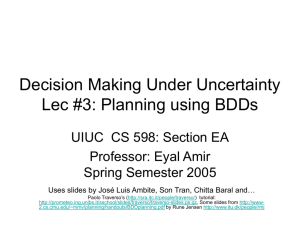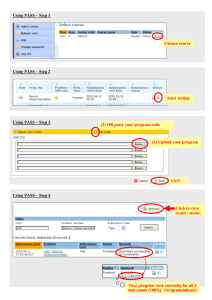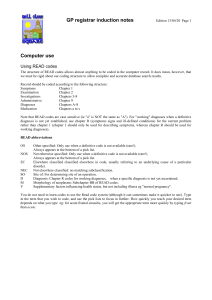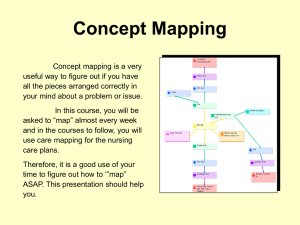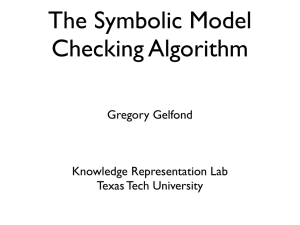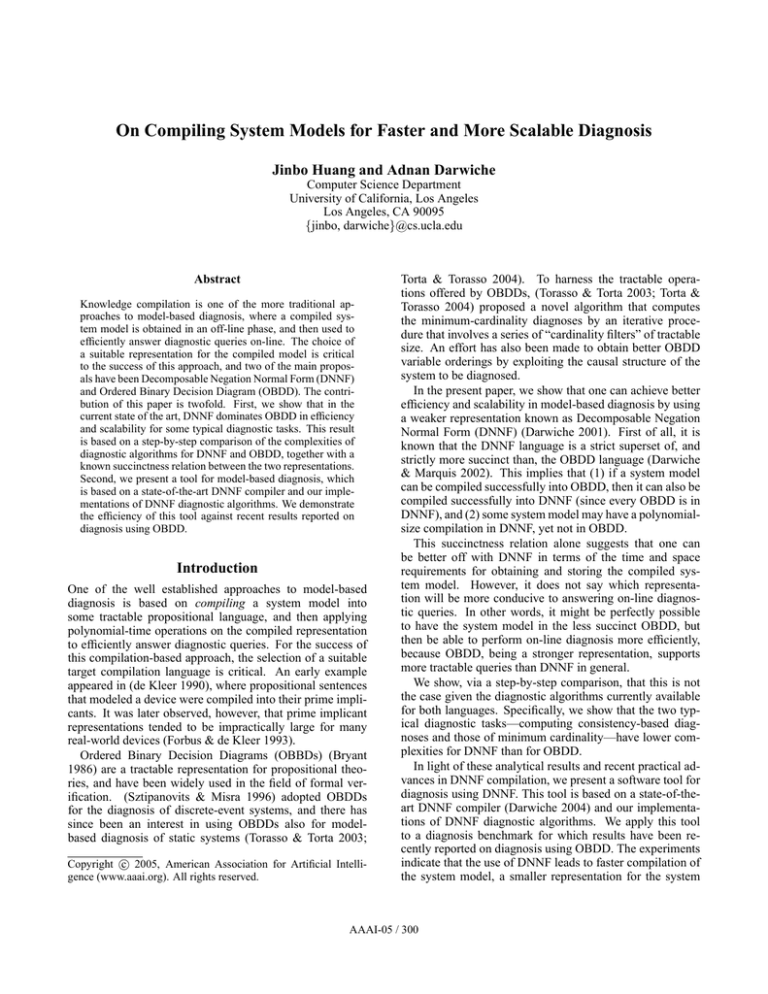
On Compiling System Models for Faster and More Scalable Diagnosis
Jinbo Huang and Adnan Darwiche
Computer Science Department
University of California, Los Angeles
Los Angeles, CA 90095
{jinbo, darwiche}@cs.ucla.edu
Abstract
Knowledge compilation is one of the more traditional approaches to model-based diagnosis, where a compiled system model is obtained in an off-line phase, and then used to
efficiently answer diagnostic queries on-line. The choice of
a suitable representation for the compiled model is critical
to the success of this approach, and two of the main proposals have been Decomposable Negation Normal Form (DNNF)
and Ordered Binary Decision Diagram (OBDD). The contribution of this paper is twofold. First, we show that in the
current state of the art, DNNF dominates OBDD in efficiency
and scalability for some typical diagnostic tasks. This result
is based on a step-by-step comparison of the complexities of
diagnostic algorithms for DNNF and OBDD, together with a
known succinctness relation between the two representations.
Second, we present a tool for model-based diagnosis, which
is based on a state-of-the-art DNNF compiler and our implementations of DNNF diagnostic algorithms. We demonstrate
the efficiency of this tool against recent results reported on
diagnosis using OBDD.
Introduction
One of the well established approaches to model-based
diagnosis is based on compiling a system model into
some tractable propositional language, and then applying
polynomial-time operations on the compiled representation
to efficiently answer diagnostic queries. For the success of
this compilation-based approach, the selection of a suitable
target compilation language is critical. An early example
appeared in (de Kleer 1990), where propositional sentences
that modeled a device were compiled into their prime implicants. It was later observed, however, that prime implicant
representations tended to be impractically large for many
real-world devices (Forbus & de Kleer 1993).
Ordered Binary Decision Diagrams (OBBDs) (Bryant
1986) are a tractable representation for propositional theories, and have been widely used in the field of formal verification. (Sztipanovits & Misra 1996) adopted OBDDs
for the diagnosis of discrete-event systems, and there has
since been an interest in using OBDDs also for modelbased diagnosis of static systems (Torasso & Torta 2003;
c 2005, American Association for Artificial IntelliCopyright °
gence (www.aaai.org). All rights reserved.
Torta & Torasso 2004). To harness the tractable operations offered by OBDDs, (Torasso & Torta 2003; Torta &
Torasso 2004) proposed a novel algorithm that computes
the minimum-cardinality diagnoses by an iterative procedure that involves a series of “cardinality filters” of tractable
size. An effort has also been made to obtain better OBDD
variable orderings by exploiting the causal structure of the
system to be diagnosed.
In the present paper, we show that one can achieve better
efficiency and scalability in model-based diagnosis by using
a weaker representation known as Decomposable Negation
Normal Form (DNNF) (Darwiche 2001). First of all, it is
known that the DNNF language is a strict superset of, and
strictly more succinct than, the OBDD language (Darwiche
& Marquis 2002). This implies that (1) if a system model
can be compiled successfully into OBDD, then it can also be
compiled successfully into DNNF (since every OBDD is in
DNNF), and (2) some system model may have a polynomialsize compilation in DNNF, yet not in OBDD.
This succinctness relation alone suggests that one can
be better off with DNNF in terms of the time and space
requirements for obtaining and storing the compiled system model. However, it does not say which representation will be more conducive to answering on-line diagnostic queries. In other words, it might be perfectly possible
to have the system model in the less succinct OBDD, but
then be able to perform on-line diagnosis more efficiently,
because OBDD, being a stronger representation, supports
more tractable queries than DNNF in general.
We show, via a step-by-step comparison, that this is not
the case given the diagnostic algorithms currently available
for both languages. Specifically, we show that the two typical diagnostic tasks—computing consistency-based diagnoses and those of minimum cardinality—have lower complexities for DNNF than for OBDD.
In light of these analytical results and recent practical advances in DNNF compilation, we present a software tool for
diagnosis using DNNF. This tool is based on a state-of-theart DNNF compiler (Darwiche 2004) and our implementations of DNNF diagnostic algorithms. We apply this tool
to a diagnosis benchmark for which results have been recently reported on diagnosis using OBDD. The experiments
indicate that the use of DNNF leads to faster compilation of
the system model, a smaller representation for the system
AAAI-05 / 300
or
x1
x2
A
B
and
x2
X
¬okX ∨ ¬A ∨ ¬C
C
Y
D
¬okX ∨ A ∨ C
¬okY ∨ B ∨ ¬D
¬okY ∨ C ∨ ¬D
¬X3
or
x3
¬okY ∨ ¬B ∨ ¬C ∨ D
and
Figure 2: A circuit and its CNF encoding.
0
X1
1
(a) OBDD
X2
(b) DNNF
Figure 1: A propositional theory represented in OBDD and
DNNF.
semantics of DNNF is defined in the straightforward way:
Each and-node (or-node) is the conjunction (disjunction) of
its children. See Figure 1b for a DNNF example.
It has been observed in (Darwiche 2001) that any OBDD
is also a DNNF sentence via the following identity: OBDD
or
X
model, faster completion of individual diagnostic cases, and
smaller representations for the sets of diagnoses computed.
The remaining sections of the paper are organized as follows: We review the definitions and theoretical relations of
the OBDD and DNNF languages; formulate the diagnosis
problem and discuss the compilation of the system model
into DNNF in the off-line phase; compare the complexities of on-line diagnostic algorithms for DNNF and OBDD
to demonstrate the better efficiency and scalability of the
DNNF-based method; describe our software tool for DNNFbased diagnosis; present results of an empirical study; and
finally conclude with a short summary of contributions.
and
and
node α
β is equivalent to DNNF node ¬X α X β.
This implies that any OBDD of tractable size immediately
gives a DNNF sentence of tractable size. The reverse, however, is not true. There are known propositional theories that
have polynomial-size representations in DNNF, but not in
OBDD (Darwiche 2001).2 As we mentioned earlier, this
relative succinctness of DNNF, by itself, does not guarantee
better performance in on-line diagnosis, but it will be the basis for our ability to achieve better efficiency and scalability
in the off-line compilation phase, as we discuss next.
Compiling the System Model
OBDD and DNNF
We briefly review in this section the definitions and theoretical relations of the OBDD and DNNF languages.
Introduced in (Bryant 1986), OBDDs are graph representations of propositional theories (or, equivalently, Boolean
functions). An OBDD is a directed acyclic graph (DAG)
with one root and at most two sinks. The sinks are labeled
with 0 and 1, respectively; every internal node is labeled
with a variable and has two children. In the example of Figure 1a, we have distinguished between the two children of
a node, commonly referred to as low and high, by using a
dotted line for the former and a solid line for the latter. It is
required that variables appear in the same order on all rootto-sink paths. An OBDD represents a propositional theory
by the following semantics: Given an instantiation I of the
variables, one picks a path from the root to a sink while always choosing the low (high) child of a node if the variable
labeling that node is set to 0 (1) by I; if the path ends with
the 0-sink (1-sink), the theory evaluates to 0 (1) for this variable instantiation.
A propositional sentence in DNNF is also a rooted DAG,
but with a different labeling scheme: Each leaf is labeled
with a literal (i.e., variable or its negation) or a constant (i.e.,
0 or 1), and each internal node is labeled with either “and” or
“or.” It is required that the DAG satisfy decomposability: No
variable is shared between children of any and-node.1 The
1
When generalized to multi-valued variables, one can observe
that DNNF is a strict superset of the AND/OR graphs recently studied in the context of belief and constraint networks (Dechter & Ma-
In this section, we formulate the problem of consistencybased diagnosis, describe the encoding of system models
and their compilation into DNNF using a state-of-the-art
compiler (Darwiche 2004), and discuss the advantages of
using DNNF over OBDD for compilation.
A system description is a triple (∆, A, O) where ∆, the
system model, is a propositional sentence describing the behavior of the system to be diagnosed, and A and O are disjoint subsets of the variables of ∆, known respectively as
assumables and observables. Intuitively, assumables represent the health of system components, and observables correspond to the appearance of the system that can be measured. Variables of ∆ that are not in A or O will be referred
to as nonobservables.
Given a system description (∆, A, O) and observation α, which is an instantiation of the observables O, a
consistency-based diagnosis is defined as an instantiation of
the assumables A that is logically consistent with ∆ ∧ α.
teescu 2004b; 2004a). In fact, even deterministic DNNF (d-DNNF)
(Darwiche & Marquis 2002), a strict subset of DNNF, is a strict superset of AND/OR graphs.
2
For example, consider 32-bit integers Xi , 0 ≤ i < n, each
represented by 32 Boolean variables Xik , 0 ≤ k < 32. It is
well-known that the OBDD encoding the proposition “not all integers Xi are distinct” has an exponential size for any variable
ordering.
W
W VThere is, however, a quadratic-size DNNF encoding:
[(Xik ∧ Xjk ) ∨ (¬Xik ∧ ¬Xjk )]. These are a class
i
j>i
k
of propositional theories that are encountered in real-world applications where, for example, one wishes to verify that “no resource
is allocated to two different users (McMillan 2002).”
AAAI-05 / 301
Consider for example the small circuit shown in Figure 2.
This circuit consists of an inverter X and an and-gate Y , and
can be modeled by the following propositional sentence:
∆ ≡ (okX ⇒ (A ⇔ ¬C))∧(okY ⇒ (B ∧C ⇔ D)). (1)
Note that we have introduced okX and okY to represent
the health of the respective components of the circuit—these
two variables are therefore the assumables. The inputs A and
B and output D of the circuit are the observables and the
internal wire C is a nonobservable. An example observation
may be ¬A∧B∧¬D, for which ¬okX ∧okY , okX ∧¬okY ,
and ¬okX ∧ ¬okY are all the possible diagnoses.
With the compilation-based approach, the diagnostic task
is divided into an off-line and an on-line phase. In this section we discuss the off-line phase, where one focuses on efficiently compiling the system model ∆ into a compact representation in some target compilation language. In the next
section we will discuss algorithms that answer on-line diagnostic queries using the compiled representation.
Compact Encoding of Multi-valued Variables
Since the behavior of a system can often be naturally described as a combination of the behaviors of its components,
from here on we assume that the system model ∆ is given
in Conjunctive Normal Form (CNF). A CNF formula is defined as a conjunction of clauses, where each clause is a disjunction of literals; a literal is a variable or its negation. For
example, the circuit in Figure 2, modeled by Equation 1, can
also be specified by the CNF formula shown to its right.
In view of the fact that many systems of interest come
with multi-valued variables, we have implemented an extension to the DNNF compiler of (Darwiche 2004), which
allows a special type of clauses, called e-clauses, to be declared as part of the input CNF. Instead of regular disjunction, an e-clause ⊕(l1 , . . . , lk ) represents the exclusive-or
of its literals. A variable x on a discrete multi-valued domain {v1 , . . . , vk } then translates into k Boolean variables
x1 , . . . , xk constrained by a single e-clause ⊕(x1 , . . . , xk ):
Each xi encodes the proposition x = vi and the e-clause encodes that variable x must assume exactly one of its values.
We note that the use of e-clauses is in contrast to
the commonly adopted method, used in (Darwiche 1998;
Torta & Torasso 2004) for example, where a regular kliteral clause: x1 ∨ . . . ∨ xk , plus k(k−1)
binary clauses:
2
¬xi ∨¬xi+1 , . . . , ¬xi ∨¬xk for i = 1 to k−1, are required to
specify the same constraint. In a search-based compiler such
as that of (Darwiche 2004), allowing the compact e-clauses
prevents the sheer volume of clauses from bogging down the
compilation when the system comes with a large number of
multi-valued variables. (For readers familiar with SAT algorithms, the compiler of (Darwiche 2004) runs a DPLL-style
search on the CNF, and an e-clause is specially marked so
that when any of its literals becomes 1 all others are immedibinary clauses
ately set to 0; not explicitly having the k(k−1)
2
shortens the watched lists of all the literals involved.)
Compiling the System Model into DNNF
Now that the system model is available in CNF (extended
to allow e-clauses), we will invoke the CNF-to-DNNF com-
Table 1: Compiling ISCAS89 circuits into OBDD & DNNF.
Circuit
Name
s820
s832
s838.1
s953
s1196
s1238
s1488
s1494
Vars
312
310
512
440
561
540
667
661
CNF
Clauses
1046
1056
1233
1138
1538
1549
2040
2040
OBDD
Size
Time
1372536 72.99
1147272 76.55
87552
0.24
2629464 38.81
4330656 78.26
3181302 158.84
6188427 50.35
3974256 31.67
DNNF
Size
Time
23347
0.07
21395
0.05
12148
0.02
85218
0.26
206830 0.44
293457 0.94
51883
0.19
55655
0.18
piler of (Darwiche 2004) to obtain a compiled representation
for the system model in DNNF.
We would like to emphasize here that this compiler derives its efficiency and scalability, in large part, from exploiting the structure of the system in a fairly systematic way.
Specifically, the compilation is driven by a decomposition
tree (dtree) for the CNF formula, which is constructed in
a preprocessing stage based on efficient heuristics that attempt to minimize its width. This results in generally efficient compilation for structured systems that admit lowwidth dtrees as the compilation is known to have a complexity that is polynomial in the number of variables and exponential only in the width of the dtree in the worst case.
This worst-case complexity of DNNF compilation was
first shown in (Darwiche 1998). However, we note that the
new DNNF compiler (Darwiche 2004) can achieve much
better performance in the average case, thanks to several additional techniques that improve search efficiency, such as
unit resolution, conflict-directed backtracking, clause learning, and more effective caching. In particular, systems with a
high width, for which the earlier compiler (Darwiche 1998)
would be hopeless as it used a strictly structure-based algorithm, are no longer necessarily difficult to compile.
In the previous section we discussed the theoretical succinctness relation between the languages of DNNF and
OBDD. On the empirical side, we would like to refer the
reader to (Darwiche 2004) for results on a set of ISCAS85
and ISCAS89 circuits,3 which were successfully compiled
into DNNF in between a few seconds and a few minutes,
yet some of which could not be compiled into OBDD using either the CUDD package (Somenzi Release 240) or the
OBDD compilation algorithm of (Huang & Darwiche 2004).
To obtain a more concrete picture of this comparison, we
experimented with a subset of these benchmark circuits, not
covered in (Darwiche 2004), where compilation is possible
for both DNNF and OBDD. For DNNF compilation we used
the compiler of (Darwiche 2004); for OBDD compilation
we used the compiler of (Huang & Darwiche 2004), with
3
These circuits are represented in CNF by introducing one variable for each internal wire and writing several clauses to model the
behavior of each logic gate. The resulting CNF formula hence includes the input, output, as well as all internal wires of the circuit,
but no assumables (i.e., variables modeling the health of the gates).
AAAI-05 / 302
or
1
or
and
and
¬C
or
1
1
and
and
C
or
or
or
0
0
or
or
¬A and
A
and
1
¬D
¬B
B
¬okX
¬okX
D
0
0
okX
1
¬okY
okY
(d) Smoothing the DNNF and computing the
minimum cardinality
¬okY
(a) Compiled system model in DNNF
or
or
and
and
and
1
1
or
and
or
¬okX
or
0
1
and
0
1
¬okX
okY
okX
¬okY
or
(e) Pruning the DNNF to obtain a representation for
minimum-cardinality diagnoses
and
1
Figure 3: Diagnosis using DNNF.
0
¬okY
(b) Restricting the model to the observation (¬A ∧ B ∧ ¬D)
and existentially quantifying the nonobservable (C)
compilation, and the compiled results are between one and
two orders of magnitude smaller in DNNF than in OBDD.
In summary, both theoretical and empirical results suggest
that the choice of DNNF over OBDD as the target language
for compiling the system model will help improve the efficiency and scalability of the off-line phase of the diagnosis.
or
The Complexities of Diagnostic Queries
¬okX
¬okY
(c) Simplifying the DNNF to obtain a representation for
all diagnoses
MINCE variable orders (Aloul, Markov, & Sakallah 2001),
as it has been reported to outperform CUDD-based compilation on these circuits (Huang & Darwiche 2004). The results are shown in Table 1. The second column of the table
gives the size of the CNF formula encoding the circuit in
terms of the number of variables and the number of clauses;
the timings are given in seconds based on a 2.4GHz CPU.
For a more meaningful comparison, the size of the compilation, for both languages, has been given in terms of the
number of edges in the DNNF DAG (each internal OBDD
node contributes 6 edges to the DNNF DAG as we illustrated earlier). We observe that for these circuits the DNNF
compilation was orders-of-magnitude faster than the OBDD
The job is but half done after successful compilation of the
system model. It remains to be seen whether the diagnostic
task can be carried out efficiently on this compiled knowledge base. We consider first the problem of computing the
complete set of diagnoses, then that of computing the set
of minimum-cardinality diagnoses only. As we shall see,
although DNNF allows fewer tractable queries, its weaker
representational requirement leads to lower complexities for
computing and representing the diagnoses than if the OBDD
representation is used.
Computing All Diagnoses
Given a system description (∆, A, O), a compilation ∆0 for
the system model ∆, and a system observation α, the complete set of diagnoses ∆d can be characterized as follows:
∆d = Project(Restrict(∆0 , α), A).
(2)
That is, we restrict the compiled system model ∆0 by incorporating the observation α, and then project the result on
the assumables A. We will define these two operations more
AAAI-05 / 303
formally later, but let us first illustrate them with a concrete
example.
Let us consider again the diagnosis of the circuit in Figure 2 under the observation α ≡ ¬A∧B∧¬D. Figure 3a depicts the compiled system model in DNNF. For the Restrict
operation, all one need do is visit the leaves of Figure 3a and
replace A with 0, ¬A with 1, B with 1, ¬B with 0, D with
0, and ¬D with 1. For the Project operation, again one visits the leaves of the DNNF but, this time, replaces both C
and ¬C with 1. The result of this process is shown in Figure 3b. The DNNF is then simplified in the straightforward
way, yielding a smaller DAG representing the set of all diagnoses, shown in Figure 3c, which basically says: Gate X
is abnormal, or gate Y is abnormal (or both). In general, one
would obtain a more complex DNNF DAG, which characterizes the set of all diagnoses. One can also enumerate the
diagnoses easily from the DNNF, but their number could be
large unless filtered further as shown below.
As we have illustrated with this example, restricting a
DNNF sentence, regardless of the number of variables involved in the instantiation, amounts to replacing the relevant
leaves with their given values. Restrict can therefore be performed in time linear in the size of the DNNF. We note that
OBDDs do just as well for this particular operation: Restricting an OBDD, also regardless of the number of variables instantiated, amounts to a single traversal of its nodes
where pointers to nodes labeled with instantiated variables
are updated (Bryant 1986).
Recall that the projection of a propositional theory Γ on
a set of variables A is the result of existentially quantifying the complement set of variables A from Γ. Existential
quantification of a single variable can be defined as:
∃xΓ ≡ Restrict(Γ, x) ∨ Restrict(Γ, ¬x).
(3)
In a typical OBDD package, existential quantification is
computed exactly according this definition. Since disjunction, as well as other binary Boolean operations, can potentially take quadratic time and produce a result of quadratic
size, using the Apply operator (Bryant 1986), it is well
known that when multiple variables are being quantified one
can encounter an exponential complexity.4
Existential quantification (and, hence, projection) is a
much easier task for DNNF as we have seen in the example. To existentially quantify a set of variables, regardless of
their number, one need only traverse the DNNF once, substituting the constant 1 for all leaves (literals) that mention
a quantified variable and eliminating redundant nodes that
result (Darwiche 2001).5
The Compilation Gets Even Smaller
Because of the low complexity of projection on DNNF, after
compiling the system model into DNNF ∆0 , one can imme4
(Torta & Torasso 2004) contains a result that if the observables
O and nonobservables N are logically dependent on the assumables A and the system context, then Equation 2 can be computed
in O((|O| + |N|) · |∆0 |2 ) time for OBDDs.
5
Since all OBDDs are in DNNF, one can do the same on an
OBDD; the result, however, will not be an OBDD. A similar argument applies to the minimization operation which we discuss later.
diately project it on the observables O and assumables A
(i.e., existentially quantify out the nonobservables) and obtain a simplified representation ∆00 :
∆00 = Project(∆0 , O ∪ A).
(4)
The diagnoses ∆d can then be computed simply as:
∆d = Restrict(∆00 , α).
(5)
In the example of Figure 3a, applying this early projection
would have removed the two nodes that mention variable
C. Each subsequent diagnostic case would then be solved
on the simpler representation. Since the compiled system
model will generally be used many times to answer diagnostic queries on-line, a smaller size to start with helps further
improve the efficiency of this phase of diagnosis.
The same technique is not always feasible with OBDDs.
Because of the potentially exponential complexity, the projection of Equation 4 may not be practical, or may result
in an OBDD much larger than the original. Under these circumstances, one would prefer to postpone the projection until the compiled system model has been restricted to a given
observation (at which point the OBDD will be smaller and
the projection will therefore be more likely to succeed), as
prescribed by Equation 2.
Computing Minimum-Cardinality Diagnoses
In cases where the set of diagnoses is large, one may be interested in only those diagnoses, called preferred diagnoses,
that satisfy one or more particular criteria. Minimum cardinality is a typical criterion used for this purpose. A diagnosis of minimum cardinality is one that identifies the smallest
possible number of faulty components.
Suppose that we have already obtained the complete set of
diagnoses ∆d using either Equation 2 or Equation 5. Computing the minimum-cardinality diagnoses will then amount
to an operation known as minimization (Darwiche 2001),
which refers to a revision of ∆d so that it encodes only
a subset of its original models (i.e., satisfying variable assignments) where the number of variables assigned 0 is the
smallest possible (without loss of generality, we assume that
an assumable, when set to 0, represents the abnormality of
the corresponding system component).
Minimization can be carried out efficiently on DNNF by
traversing the DAG exactly three times (Darwiche 2001). In
the first traversal, the DNNF is smoothed so that disjuncts of
any disjunction mention the same set of variables; see Figure 3d. Smoothing takes O(|∆d | · |A|) time and results in
a new DAG of size O(|∆d | · |A|).6 The second traversal
computes the mc (minimum cardinality) for each node of
the DAG: The mc of a positive (negative) literal is 0 (1); the
mc of an or-node (and-node) is the minimum (sum) of the
mc’s of its children; see Figure 3d. This computation takes
6
One can omit this smoothing step; the final DNNF for
minimum-cardinality diagnoses should then be interpreted differently: When enumerating the models (diagnoses) of the DNNF,
assume that variables with unspecified values are assigned 1. This
alternative method can be slightly more efficient in practice, and
was used for the experiments reported later.
AAAI-05 / 304
Table 2: The complexity of diagnosis: A comparison of
state-of-the-art algorithms.
Operation
Restrict(∆0 , α)
Project(Γ, A)
Minimize(∆d )
OBDD
O(|∆0 |)
exponential
O(mc · |∆d | · |A|2 )
DNNF
O(|∆0 |)
O(|Γ|)
O(|∆d | · |A|)
time linear in the size of the smoothed DNNF. The final traversal visits every or-node and cuts off all its children whose
mc is greater than that of their parent. This simplification
produces a DAG that encodes exactly the diagnoses of minimum cardinality, again taking time linear in the size of the
smoothed DNNF. The overall complexity of minimization is
therefore O(|∆d | · |A|).
Figure 3e depicts the result of applying minimization to
Figure 3c. The number of diagnoses is now down to 2—the
diagnosis with two abnormal gates has been wiped out.
Minimization of OBDDs is not as trivial. The most recent algorithm for this purpose appeared in (Torta & Torasso
2004); it works by constructing a series of OBDDs F ilter[k]
so that when F ilter[k] is conjoined with the OBDD ∆d encoding the complete set of diagnoses, the resulting OBDD
Apply(∧, ∆d , F ilter[k])
(6)
will characterize exactly all diagnoses of cardinality k. The
algorithm then iteratively runs Equation 6 for increasing values of k, starting from 0, until the resulting OBDD characterizes a nonempty set of diagnoses (i.e., is not the 0-sink).
According to (Torta & Torasso 2004), all the OBDD filters
F ilter[k] have size O(|A|2 ) regardless of k. Hence computing Equation 6 takes O(|∆d | · |A|2 ) time and the overall algorithm, having to run mc (minimum cardinality) iterations,
takes O(mc · |∆d | · |A|2 ) time, which is clearly greater than
the O(|∆d | · |A|) complexity for DNNF minimization.
We close this section by summarizing in Table 2 the main
complexity results that we have compared for diagnosisrelated operations on OBDD and DNNF.
A DNNF-based Tool for Diagnosis
We implemented the DNNF diagnostic algorithms,
linked them with the DNNF compiler of (Darwiche
2004) (extended to allow e-clauses), and produced a
tool for efficient model-based diagnosis (available at
http://reasoning.cs.ucla.edu/). Given a system description
(∆, A, O) where ∆ is in CNF, and an observation on variables O, this tool computes consistency-based diagnoses of
minimum cardinality as described in the previous section.
In addition, it has the following two features:
• For particularly large systems where the compilation of
CNF ∆ may be difficult, an alternative is offered where
∆ is first simplified by setting all the O variables to their
observed values, and then compiled into DNNF. The result is again projected on the assumables A to produce the
diagnoses as before. The drawback of this method is that
compilation has to be done for each diagnostic case, even
Table 3: Using DNNF vs. OBDD on a diagnosis benchmark.
Diagnosis in
∆0
∆d
∆mcd
3 Steps →
Size
Time
Size
Size
Time
OBDD-S2 375500 × 6 12.19 2678 × 6 79 × 6 0.051
OBDD-S3
59000 × 6 1.81 3229 × 6 77 × 6 0.035
DNNF
3750
0.05
85
42
0.011
though the system model remains unchanged. Scalability
can be significantly extended, however, because instantiating the observables in ∆ can substantially reduce its
size, making compilation more likely to succeed.
• An efficient verification component is built into the tool,
which invokes an independent SAT solver (zChaff-04) to
verify the correctness of the diagnoses computed: A diagnosis d is proved correct for a system model ∆ and observation α if ∆ ∧ α ∧ d is found satisfiable by the SAT
solver. The minimum-cardinality diagnoses we report in
the next section have all been verified in this manner. (We
have also verified that they are indeed of minimum cardinality by using the SAT solver, in a brute-force search, to
prove that no diagnosis of lower cardinality exists.)
An Empirical Study
Our goal in this section is to empirically compare the
DNNF-based and OBDD-based approaches on a real-world
diagnostic problem. Since (Torta & Torasso 2004) contains
an empirical evaluation of the OBDD-based approach, we
took the benchmark that was used there, and applied the tool
that we described above to solve the same diagnostic tasks—
computing the diagnoses as well as minimum-cardinality diagnoses. The experiments were run on a 2.4GHz processor
and allocated 512MB of memory.
The said benchmark consists of a model of an industrial
plant and 3000 diagnostic cases each “containing between 1
and 3 faults.” After translating the system model, originally
given in XML, into CNF, we obtained a formula with 279
Boolean variables and 386 clauses, of which 36 are e-clauses
(i.e., 36 of the variables in the original system model are
multi-valued).
Our task was then completed in three steps. First, we
compiled the CNF formula into DNNF. The compilation
took only 0.05 second and the resulting DNNF had 1600
nodes and 3750 edges.7 In the second step, and for each
of the 3000 diagnostic cases (one of these turned out to be
invalid and was not used), we computed the set of all diagnoses (of any cardinality) as a DNNF DAG. The average
running time per case was 0.0111 second and the average
DNNF had 65 nodes and 85 edges. Finally, we minimized
the DNNF to produce the set of minimum-cardinality diagnoses. This took an extra 0.0002 second and resulted in a
DNNF DAG with 40 nodes and 42 edges on average.
7
Using Equation 4 would knock it down to 830 nodes and 1605
edges without noticeable increase in the running time. Our subsequent computation was based on this simplified compilation; we
report the size of the full compilation here for the later comparison
with its OBDD counterpart.
AAAI-05 / 305
The same benchmark posed an initial challenge for the
OBDD-based approach (Torta & Torasso 2004): Much effort was required to obtain a suitable variable ordering and
even the two best orderings found led to relatively large OBDDs. See Table 3: The first two rows of data correspond to
the two sets of results reported in (Torta & Torasso 2004)
based on the two best OBDD variable orderings found,8
and the last row summarizes our corresponding results for
DNNF described above. The three columns of data correspond to the three diagnosis steps described above. The
DAG size again reflects the number of DNNF edges (recall
from the second section that an internal OBDD node contributes 6 DNNF edges).
It can be clearly seen that on this benchmark the use of
DNNF has led to faster compilation and diagnosis, as well as
smaller representations for the system model and the sets of
diagnoses. Together with the data in Table 1 and (Darwiche
2004), these results empirically support the role of DNNF
compilation in improving the efficiency and scalability of
model-based diagnosis.
Conclusion
We systematically compared the use of OBDD and DNNF
as target compilation languages in model-based diagnosis. In particular, we demonstrated theoretically that using the less constrained DNNF language can lead to more
efficient and scalable compilation as well as diagnosis.
We presented a DNNF-based diagnosis tool (available at
http://reasoning.cs.ucla.edu/), and empirically compared the
DNNF-based and OBDD-based approaches on a diagnosis
benchmark.
Acknowledgments
We would like to thank the authors of (Torta & Torasso
2004) for generously providing their benchmark and the
two unpublished timings and kindly answering our questions
about the benchmark. Thanks also to the anonymous reviewers for their helpful comments. This work has been partially
supported by Air Force grant FA9550-05-1-0075 and MURI
grant N00014-00-1-0617.
References
Aloul, F.; Markov, I.; and Sakallah, K. 2001. Faster SAT
and smaller BDDs via common function structure. In International Conference on Computer Aided Design (ICCAD),
443–448.
8
The timings for computing minimum-cardinality diagnoses
using OBDDs were reported in (Torta & Torasso 2004) as 0.125
and 0.09 second based on a 933MHz processor; the timings for
the compilation of the system model into OBDD have been provided by Gianluca Torta as 20.9 and 3.1 seconds based on a 1.4GHz
processor. We have scaled these numbers accordingly to reflect the
speed of our 2.4GHz processor.
Bryant, R. E. 1986. Graph-based algorithms for Boolean
function manipulation. IEEE Transactions on Computers
C-35:677–691.
Darwiche, A., and Marquis, P. 2002. A knowledge compilation map. Journal of Artificial Intelligence Research
17:229–264.
Darwiche, A. 1998. Model-based diagnosis using structured system descriptions. Journal of Artificial Intelligence
Research 8:165–222.
Darwiche, A. 2001. Decomposable negation normal form.
Journal of the ACM 48(4):608–647.
Darwiche, A. 2004. New advances in compiling CNF
into decomposable negation normal form. In Proceedings
of the 16th European Conference on Artificial Intelligence
(ECAI), 328–332.
de Kleer, J. 1990. Compiling devices and processes. Presented at the Fourth International Workshop on Qualitative
Physics, Lugano, Switzerland.
Dechter, R., and Mateescu, R. 2004a. The impact
of AND/OR search spaces on constraint satisfaction and
counting. In Proceedings of the Tenth International Conference on Principles and Practice of Constraint Programming (CP), 731–736.
Dechter, R., and Mateescu, R. 2004b. Mixtures of
deterministic-probabilistic networks and their AND/OR
search spaces. In Proceedings of the 20th Conference on
Uncertainty in Artificial Intelligence (UAI), 120–129.
Forbus, K. D., and de Kleer, J. 1993. Building Problem
Solvers. MIT Press.
Huang, J., and Darwiche, A. 2004. Using DPLL for efficient OBDD construction. In Proceedings of the Seventh
International Conference on Theory and Applications of
Satisfiability Testing (SAT), 127–136.
McMillan, K. L. 2002. Applying SAT methods in unbounded symbolic model checking. In Proceedings of the
14th International Conference on Computer Aided Verification (CAV), 250–264.
Somenzi,
F.
Release 2.4.0.
CUDD:
CU
Decision
Diagram
Package.
http://vlsi.colorado.edu/˜fabio/CUDD/cuddIntro.html.
Sztipanovits, J., and Misra, A. 1996. Diagnosis of discreteevent systems using ordered binary decision diagrams. In
Seventh International Workshop on Principles of Diagnosis
(DX).
Torasso, P., and Torta, G. 2003. Computing minimumcardinality diagnoses using OBDDs. In Proceedings of the
26th Annual German Conference on Artificial Intelligence
(KI), 224–238.
Torta, G., and Torasso, P. 2004. The role of OBDDs in controlling the complexity of model-based diagnosis. In 15th
International Workshop on Principles of Diagnosis (DX).
AAAI-05 / 306

